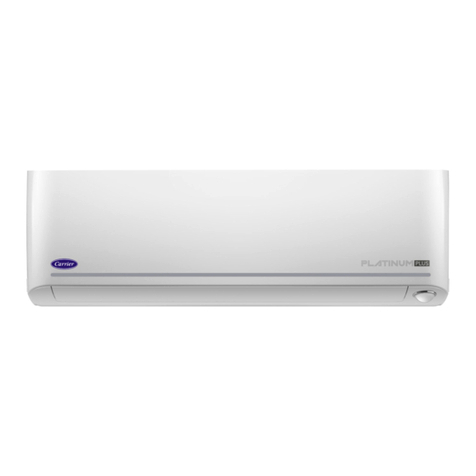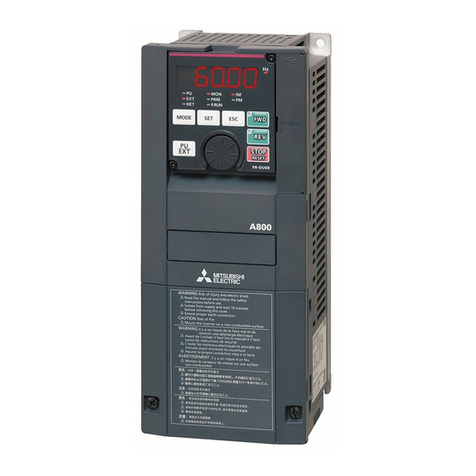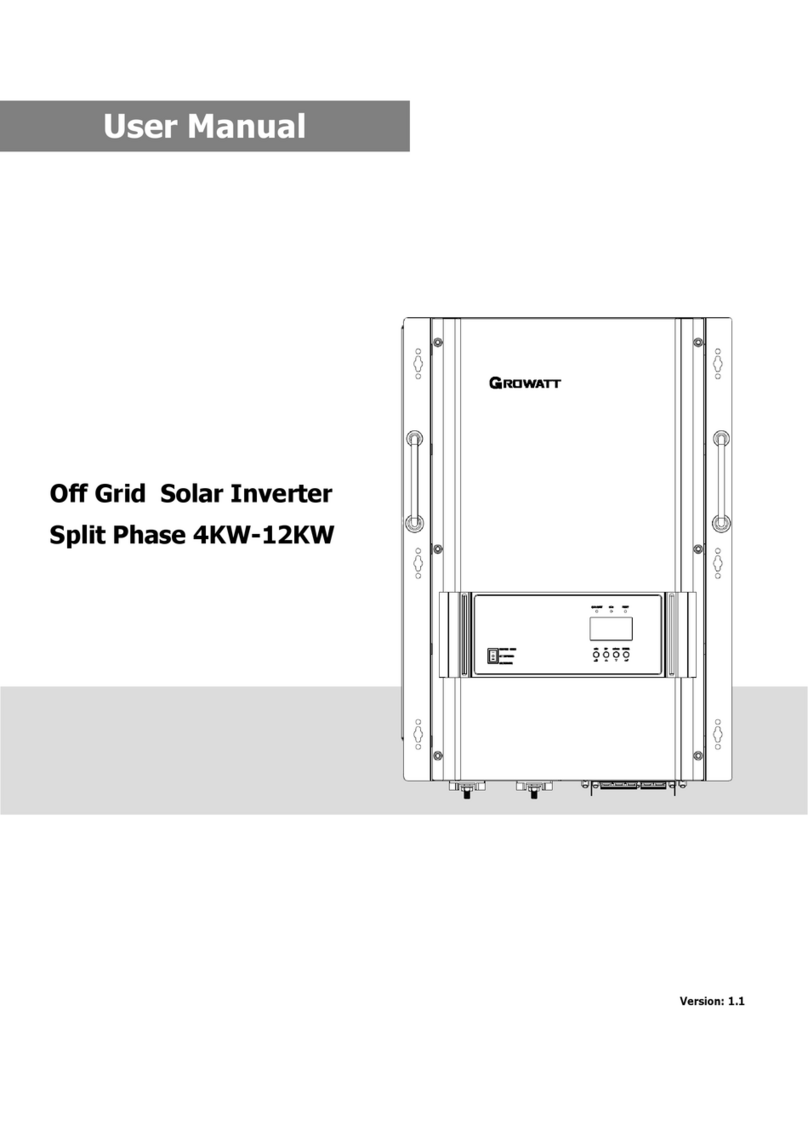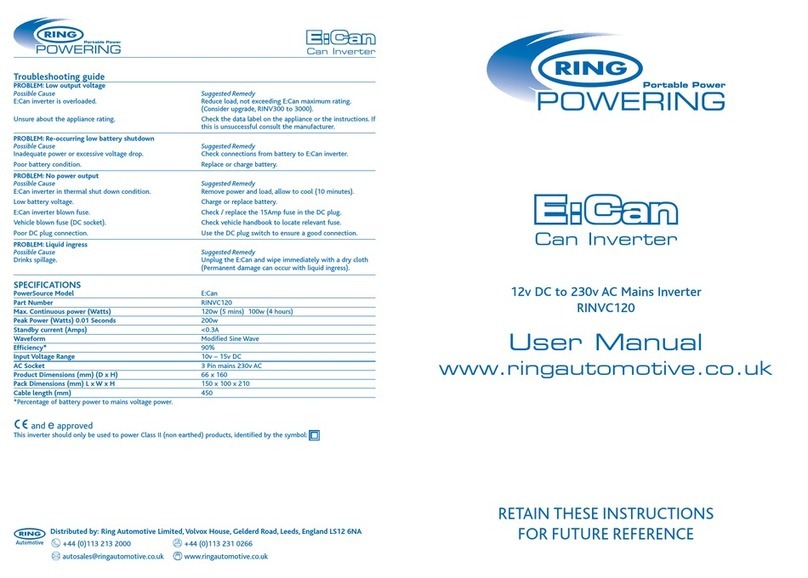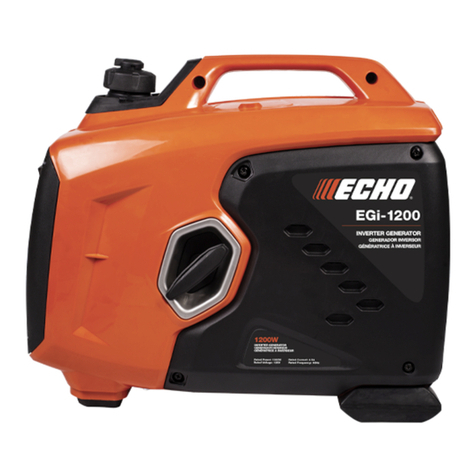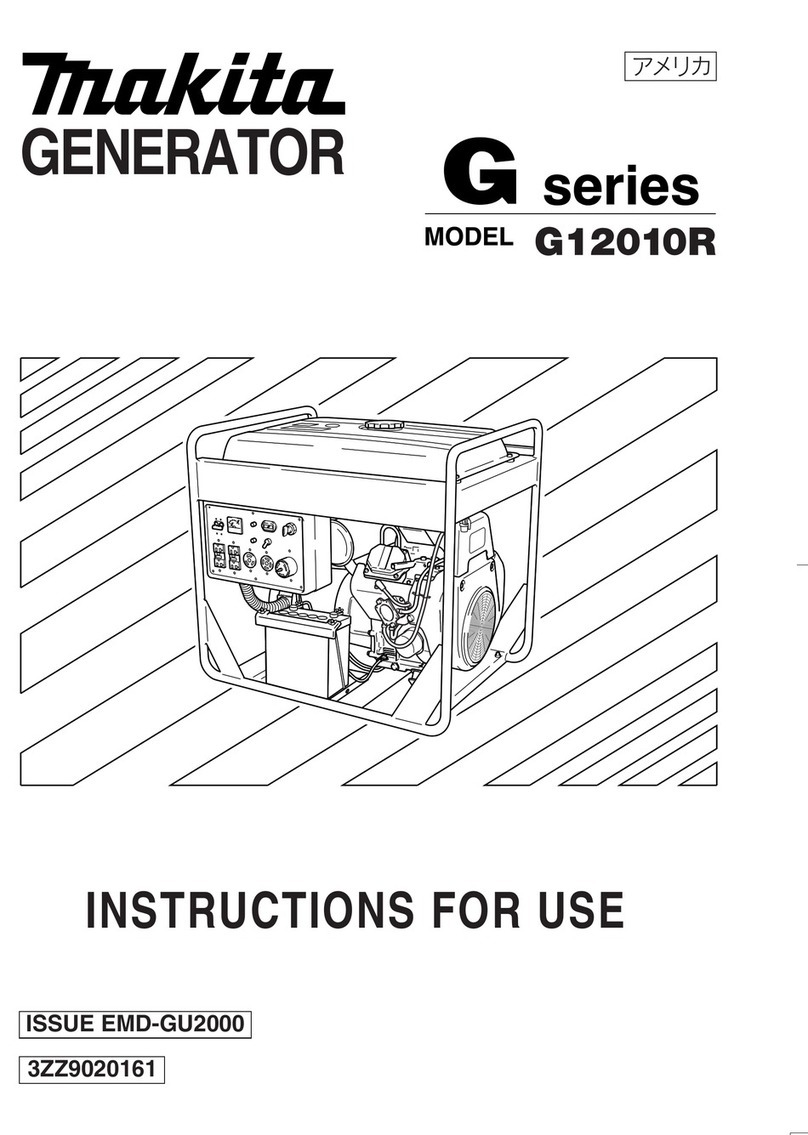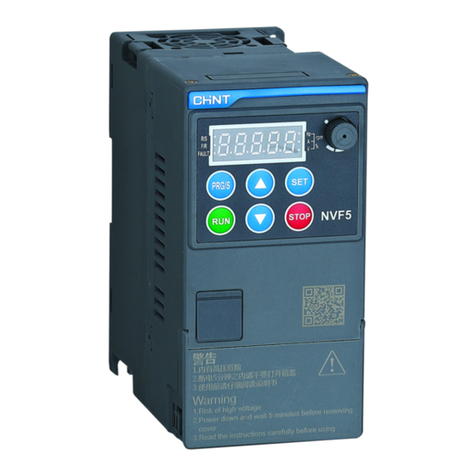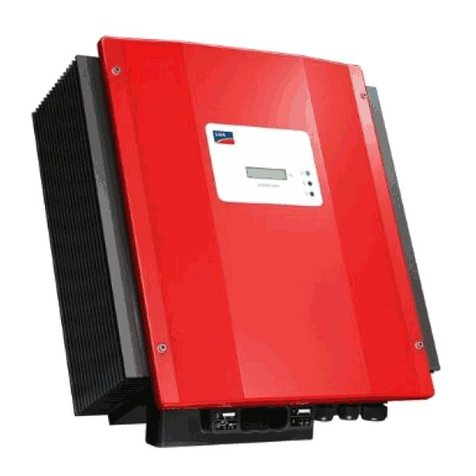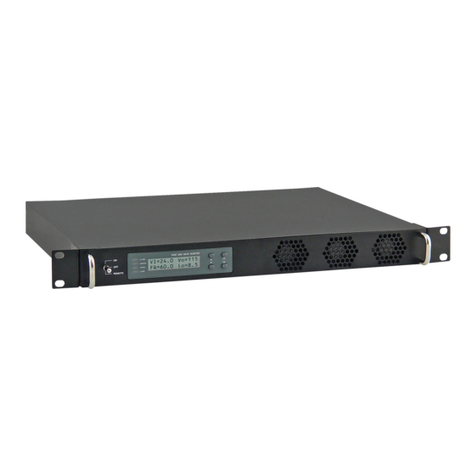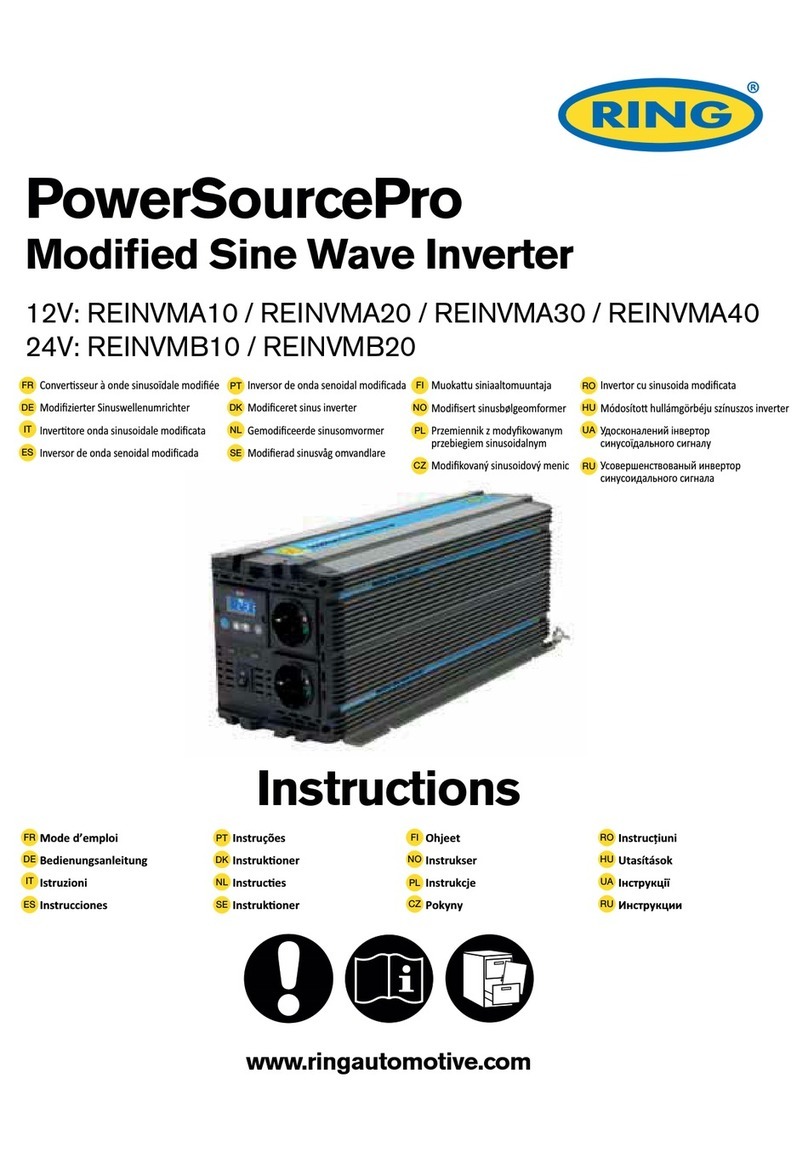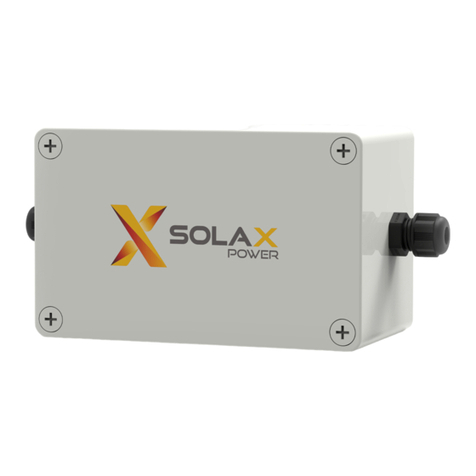STMicroelectronics STEVAL-CTM004V1 User manual

Introduction
The STEVAL-CTM009V1 evaluation kit for motor control is designed to demonstrate the capabilities of ST Power MOSFETs
based on STripFET™ F7 technology. The 100V STripFET™ F7 devices (STH31*N10F7) are ideal for low voltage (up to 48 V),
high current applications such as forklifts, golf carts and power tool.
The STEVAL-CTM004V1 power board features an insulated metal substrate (IMS), NTCs for thermal protection and decoupling
gate resistors for each power MOSFET. The board mounts ST devices in the H²PAK-6 package.
The driver stage is an STEVAL-CTM006V1 board with L6491 high current capability gate drivers to drive the power MOSFETs
and integrated comparator for protections. The driver board includes the ST motor control connector, so you can interface the
STEVAL-CTM009V1 with any ST MCU control board suitable for motor control (not included in the kit).
The system also has an STEVAL-CTM005V1 bus link capacitor board and an STEVAL-CTM008V1 current sensing board.
Figure 1. STEVAL-CTM009V1 evaluation kit
5 kW low voltage high current inverter for industrial motor control applications
UM2458
User manual
UM2458 - Rev 1 - October 2018
For further information contact your local STMicroelectronics sales office.
www.st.com

1Evaluation kit features
1.1 Electrical and functional characteristics
The kit features the following main characteristics:
•Power board with insulated metal substrate (IMS) hosting 36 STH310N10F7 or STH315N10F7 power
MOSFETS in the H²PAK-6 (6x switch) package, designed also for automotive applications.
• High and low-side, high current capability (L6491) gate driver with integrated comparator for fast protection
and smart shutdown functions.
• Maximum power 5 kW at 48 V.
• Isolated current sensing, bus voltage and temperature monitoring.
1.2 Target applications
The STEVAL-CTM009V1 kit is designed for applications involving motor drives for electric traction, such as:
•forklifts
• golf carts
• E-rickshaw
UM2458
UM2458 - Rev 1 page 2/40

2Safety and operating instructions
2.1 General terms
All operations involving transportation, installation and use, as well as maintenance, has to be carried out by
skilled technical personnel (national accident prevention rules must be observed). For the purpose of these basic
safety instructions, "skilled technical personnel" are considered as suitably qualified people who are familiar with
the installation, use, and maintenance of power electronic systems.
2.2 Intended use of evaluation kit
This evaluation kit is designed for demonstration purposes only and shall not be used for any commercial
purpose. The technical data, as well as information concerning power supply conditions, must be taken from the
relevant documentation and strictly observed.
2.3 Evaluation kit setup
• The evaluation kit must be set up in accordance with the specifications and the targeted application.
•The board contains electro-statically sensitive components that are prone to damage through improper use.
Electrical components must not be mechanically damaged or destroyed.
• Avoid any contact with other electronic components.
• During the motor driving, converters must be protected against excessive strain. Do not bend or alter the
isolating distances any components during transportation or handling.
2.4 Electronic connections
Applicable national accident prevention rules must be followed when working on the main power supply with a
motor drive. The electrical installation must be completed in accordance with the appropriate requirements. A
system architecture which supplies power to the evaluation board must be equipped with additional control and
protective devices in accordance with the applicable safety requirements (e.g., compliance with technical
equipment and accident prevention rules).
UM2458
UM2458 - Rev 1 page 3/40

3Evaluation kit overview
The STEVAL-CTM009V1 evaluation kit is designed to let you evaluate STH31*N10F7 power MOSFETs, which
are driven by high and low-side, L6491 high current capability gate drivers. The system includes a bulk capacitor
board and a current sensing board.
The STEVAL-CTM009V1 can be interfaced with any ST MCU evaluation board with embedded ST motor control
and ST FOC firmware library support.
This kit has been tested with the STEVAL-CTM001V1C (not included in this kit) control board of the STEVAL-
HKI001V1 kit), which features an STM32F303RB 32-bit microcontroller.
Figure 2. STEVAL-CTM009V1 block diagram
DRIVING STAGEPOWER STAGE
Not used
Motor Control
ICS
Ph_U driving
circuitry
Ph_V driving
circuitry
Ph_W driving
circuitry
Vin
L6491
driver
3V3 DC/DC 5V DC/DC
12V DC/DC
DRV->PW DRV->PW DRV->PW
L6491
driver
L6491
driver
ENC/HALL
PW->DRV PW->DRV PW>DRV
12x
STH315N10F7
in H2PAK-6
-
Phase_U Phase_V Phase_W
Shunt
resistor
Shunt
resistor
Shunt
resistor
12x
STH315N10F7
in H2PAK-6
12x
STH315N10F7
in H2PAK-6
connector on top
connector on bottom
NTC
LEGEND
UM2458
Evaluation kit overview
UM2458 - Rev 1 page 4/40

4STEVAL-CTM004V1 power board
The STEVAL-CTM004V1 power board of the evaluation kit has 36 STH31*N10F7 N-channel Power MOSFETS in
the H²PAK-6 package. A gate resistor is placed near each power MOSFET to eliminate parasitic oscillation. A
pull-down resistor between the gate and the source of each transistor helps to avoid capacitive coupling driving
the transistor and unwanted switch-on when gate is floating. A snubber RC circuit on each switch limits the rate of
voltage change during switching transitions to reduce electromagnetic interference (EMI) and losses.
two decoupling capacitors close to the switching power MOSFETs reduce ringing on the VDS and voltage stress
on the devices. The capacitors reduce voltage overshoot caused by abrupt current change in the parasitic
inductors in the circuit.
To monitor the temperature of the power board and provide over-temperature protection, three NTCs are placed
on the power board near the drain of one power MOSFET for each inverter leg.
The power section also has connectors for the driver board, with CON5 (phase_U), CON6 (phase_V) and CON7
(phase_W) for gate driving and NTC sensing, and J3 for bus voltage. The board also hosts six towers near the
bulk capacitor board connection and three towers near the motor connection.
Figure 3. Main blocks of the STEVAL-CTM004V1 power board
4.1 STH315N10F7 N-channel Power MOSFET characteristics
The N-channel Power MOSFETs use STripFET™ F7 technology with an enhanced trench gate structure for very
low on-state resistance and reduces internal capacitance and gate charge for faster and more efficient switching.
The STH315N10F7 N-channel Power MOSFET has the following features:
• Designed for automotive applications and AEC-Q101 qualified
UM2458
STEVAL-CTM004V1 power board
UM2458 - Rev 1 page 5/40

• Among the lowest RDS(on) on the market
•Excellent figure of merit (FoM)
• Low Crss/Ciss ratio for EMI immunity
• High avalanche ruggedness
Figure 4. Package and internal schematic diagram
UM2458
STH315N10F7 N-channel Power MOSFET characteristics
UM2458 - Rev 1 page 6/40

5Driver board and control board overview
Figure 5. STEVAL-CTM006V1 driver board functional blocks
1. connections to power board
2. motor control connector
3. ENC/HALL connector
4. ICS connector
5. L6491 drivers
6 3V3 DC/DC regulation
7. 5V DC/DC regulation
8. 12V DC/DC regulation
11 1
1555
4
3
7
8
6
2
5.1 STEVAL-CTM006V1 driver board
5.1.1 Power supply section
The power supply section provides all the voltages necessary for the circuitry. The required input voltage is 8 to
36 V input, which is supplied through connector JP1.
The input voltage is then converted to the following voltage levels:
•+12V for gate driver section (via an A7986 3 A step-down switching regulator)
• +5V and +3.3V for the control board (via an A6902 1 A switch step-down regulator)
5.1.2 Bus voltage monitoring
Bus voltage monitoring is implemented across an input voltage range of 5 to 75 V.
The following table shows the measured input voltage and the corresponding voltage level sent to the ADC input
of the STM32 microcontroller unit.
Table 1. Input voltage bus and input signal to STM32 ADC channel
Input Voltage ADC input
48V 2.0V
75V (max value) 3.1V
5.1.3 Temperature monitor
Three NTCs are placed on the power section to provide temperature information, although only one NTC may be
chosen at a time. Close one of the three jumpers S1, S2 or S3 to read the temperature near the U, V or W phase,
respectively. The microcontroller monitors processed signals to determine the temperature of the driver board and
manage any overload or over-temperature conditions.
To protect the hardware from excess temperature, a safe threshold is set in the STM32 FOC SDK software library.
UM2458
Driver board and control board overview
UM2458 - Rev 1 page 7/40

Table 2. NTC electrical characteristics
Symbol Parameter Test Condition Min Typ Max Unit
R-40 Resistance T = -40°C - 105.7 - kΩ
R25 Resistance T = 25°C - 4.7 - kΩ
R100 Resistance T = 100°C - 0.426 - kΩ
B B- constant T = 25°C to 50°C - 3500 - -
T Operating temp range -40 125 °C
5.1.4 L6491 gate driver characteristics
The L6491 gate driver has the following main features:
•dV/dt immunity ± 50 V/ns in full temperature range
• Driver current capability: 4 A source/sink
• Switching times 15 ns rise/fall with 1 nF load
• 3.3 V, 5 V TTL/CMOS inputs with hysteresis
• Integrated bootstrap diode
• Comparator for fault protections
• Smart shutdown function
• Adjustable deadtime
• Interlocking function
• Compact and simplified layout
• Bill of material reduction
• Effective fault protection
• Flexible, easy and fast design
For detailed information on the product, see the device datasheet.
Figure 6. L6491 gate driver pin-out
Table 3. Pin functions of L6491 gate driver
Pin number Pin name Type Function
1 LIN I Low-side driver logic input (active low)
2SD / OD I/O
Shutdown logic input (active low)/open-drain
comparator output
3 HIN I High-side driver logic input (active high)
UM2458
UM2458 - Rev 1 page 8/40

Pin number Pin name Type Function
4 VCC P Lower section supply voltage
5 DT I Deadtime setting
6 SGND P Signal ground
7 PGND P Power ground
8 LVG O Low-side driver output
9 CP- I Comparator negative input
10 CP+ I Comparator positive input
11 NC Not connected
12 OUT P High-side (floating) common voltage
13 HVG O High-side driver output
14 BOOT P Bootstrapped supply voltage
UM2458
UM2458 - Rev 1 page 9/40

6STEVAL-CTM005V1 bus link capacitor board
In EV inverter systems, bus link capacitors reduce ripple current and suppress voltage spikes caused by leakage
inductance and switching operations. These capacitors provide a low impedance path for the ripple currents
caused by output inductance load, the bus voltage and PWM frequency.
The bus link capacitors must sustain a ripple current given by the following formula:
ΔI0.5t=0.25 × Vbus
f×L
Where:
•ΔI0.5t is the maximum ripple current when duty cycle is 50%
• Vbus is the bus voltage
• f is the switching frequency
• L is the load inductance.
For a very low inductance motor (worst case scenario), ΔI0.5t is about 48 ARMS (Vbus = 52 V, f = 8 kHz and
L = 12 μH). If we add 10% to ΔI0.5t and choose electrolytic capacitors with a ripple current of 2.4 A, 22 electrolytic
capacitors are required. The resulting capacitance is about 6 mF, leading to a negligible ripple voltage on the bus.
Figure 7. STEVAL-CTM005V1 bus link capacitor board
6.1 STEVAL-CTM008V1 current sensing board
The STEVAL-CTM008V1 current sensing board is a general purpose board for motor control that can read up to
three phase motor currents and DC bus currents if four ICS are on-board. The board included in the kit hosts two
ICS to read two phase currents.
This sensing feature determines motor currents for digital control based on FOC algorithms. The sensors provide
high accuracy, with 4 mV/A over a temperature range of -40 °C to +105 °C and a nominal current of 200 ARMS.
The internal reference voltage of the ICSs (according to their VCC) is generally used, but the reference voltage
can be overdriven by providing an external reference voltage through the J1 connector. A female to female flat
cable is used to connect CON2 on the driver board with J1 on the current sensing board.
The signals from the sensors center around 1.65 V (average value at zero current).
UM2458
STEVAL-CTM005V1 bus link capacitor board
UM2458 - Rev 1 page 10/40

Figure 8. STEVAL-CTM008V1 current sensing board
UM2458
STEVAL-CTM008V1 current sensing board
UM2458 - Rev 1 page 11/40

7How to set up the system
Follow the steps below to set up the evaluation kit.
Step 1. Mount the STEVAL-CTM004V1 power board heatsink.
Use standard thermal interface material or a graphite sheet for high thermal conductivity
Step 2. Connect the STEVAL-CTM004V1 power board with the STEVAL-CTM006V1 driver board.
– use connectors CON5, CON6, CON7 and J3 on the STEVAL-CTM004V1 power board
– use connectors CON1, CON3, CON4 and J2 on the STEVAL-CTM006V1 driver board
Step 3. Connect the control board:
– If you use the STEVAL-CTM001V1C control board (not included in the kit):
◦ use connectors J1 and J4 on the STEVAL-CTM006V1 driver board
◦ use connectors CON3 and CON1 on the STEVAL-CTM001V1C control board.
– If you use a control board that is not the STEVAL-CTM001V1C:
◦ Use connector J1 on the driver board.
Step 4. Mount the STEVAL-CTM005V1 bus link capacitor board on the STEVAL-CTM004V1 power board
Step 5. Set up the STEVAL-CTM001V1C control board (optional, if present).
– close jumper SW5 in the default position (indicated near the switch)
– connect ST-LINK to the CON14 connector
– connect the USB to serial converter to the P2 with a serial cable DB9 female to female
Step 6. Set up the STEVAL-CTM006V1 driver board.
– close jumper S1, S2 or S3 to read one of the three NTCs on the power stage
– connect a 12 V DC power supply to the JP1 connector and turn on the power supply
Step 7. Connect the flat cable between CON2 on the STEVAL-CTM006V1 driver board and J1 on the STEVAL-
CTM008V1 current sensing board.
Step 8. Connect a 48 VDC power supply to the STEVAL-CTM006V1 driver board.
Step 9. Connect the phase motor cables to the STEVAL-CTM004V1 power board.
7.1 Connectors
In addition to the connector used for the supply voltage, the driving board has connectors to plug it to the power
board and the control board, and to receive external signals.
•Connector for supply voltage: provided at JP1 (8 to 36 V).
• Connectors to the power board:
– CON1, CON3 and CON4: for power MOSFET driving and NTC sensing.
– J2: connector for DC bus voltage sensing (fpr undervoltage and overvoltage protection).
• Connectors to the control board
– J1: motor control connector, including signals like fault management, bus voltage monitoring, power
board temperature sensing and current sensing.
– J4: connector used for mechanical robustness when a control board (e.g., STEVAL-CTM001V1C, not
included in kit) is plugged but not electrically connected.
• Connectors for external signals
– CON8 (ENC/HALL connector): to receive external signals from Encoder/Hall sensors and provides
+3V3 or +5V supply voltages.
– CON2 (CURRENT SENSING connector): to receive current signals from the external current sensor
board and provide a +5V supply voltage.
UM2458
How to set up the system
UM2458 - Rev 1 page 12/40

Figure 9. Current sensing connector (CON2 on driver board)
Table 4. Current sensing connector pinout
Pin number Pin name / Function
1 Ground
2 ADC_U
3 Ground
4 ADC_V
5 Ground
6 ADC_W
7 Ground
8 Not Connected
9 Ground
10 Vcc_ICS
Figure 10. 34-pin motor control connector (J1 on the driver board)
Table 5. Motor control connector pinout
Pin number Pin name / Function Pin number Pin name / Function
1 FAULT 18 Ground
2 Ground 19 ADC_W
3 PWM_U_H 20 Ground
4 Ground 21 Not connected
UM2458
Connectors
UM2458 - Rev 1 page 13/40

Pin number Pin name / Function Pin number Pin name / Function
5 PWM_U_L 22 Not connected
6 Ground 23 Not connected
7 PWM_V_H 24 Not connected
8 Ground 25 5V
9 PWM_V_L 26 Heatsink temperature signal
10 Ground 27 Not connected
11 PWM_W_H 28 3.3V
12 Ground 29 Not connected
13 PWM_W_L 30 Ground
14 Bus voltage monitoring 31 Enc A/H1
15 ADC_U 32 Ground
16 Ground 33 Enc B/H2
17 ADC_V 34 Enc Z/H3
7.2 Signal LEDs
Table 6. LEDs Indicators on board
Name Color Description Location
D1 RED 3V3 STEVAL-CTM006V1
D2 RED 5V STEVAL-CTM006V1
D3 RED 12V STEVAL-CTM006V1
D53 RED 48V STEVAL-CTM004V1
7.3 Push buttons
Table 7. Push buttons
Name Description Location
SW6 STM32 microcontroller reset Control Board
SW7 User push-button Control Board
UM2458
Signal LEDs
UM2458 - Rev 1 page 14/40

8Firmware for STM32 PMSM FOC SDK
This evaluation kit is compatible with latest X-CUBE-MCSDK - STM32 FOC firmware library, please visit the X-
CUBE-MCSDK web page on www.st.com for information and installation instructions.
8.1 Firmware for STM32 PMSM FOC SDK
You can use the ST Motor control workbench to customize the STM32 FOC library (installed together with the X-
CUBE-MCSDK package). The required parameters for the power stage of the STEVAL-CTM009V1 are given in
the following table.
Parameter Value Unit
Inrush current limiter disabled -
Dissipative brake disabled -
Bus voltage sensing Enabled -
R1 (Bus voltage sensing) 63.9 kΩ
R2 (Bus voltage sensing) 2.7 kΩ
Min. rated voltage 36 V
Max. rated voltage 60 V
Nominal voltage 48 V
Temperature sensing Enabled -
V0 761 mV
T0 25 °C
ΔV/ΔT 21 mV/°C
Max. working temperature on sensor 125 °C
Current sensing Enabled -
Current reading topology Two insulated current sensors -
ICS gain 0.004 V/A
Overcurrent protection disabled -
Power switches - switching frequency 12
(can be changed according the requirements) kHz
Power switches - dead-time 2
(can be changed according the requirements) µs
U,V,W driver
High side driving signal polarity Active high -
U,V,W driver
Low side driving signal
Complemented from high side
disabled -
U,V,W driver
Low side driving signal
Polarity
Active low -
UM2458
Firmware for STM32 PMSM FOC SDK
UM2458 - Rev 1 page 15/40

Parameter Value Unit
U,V,W driver
Force same values for U, V, W driver enabled -
U,V,W driver
Use STGAP1S gap drive disabled -
UM2458
Firmware for STM32 PMSM FOC SDK
UM2458 - Rev 1 page 16/40

9Experimental measurements
The experimental results were obtained by testing the system at maximum power rating.
The power board was mounted with a heatsink (manuf.: ABL Components; manuf. order code: 159AB2000B; Rth:
0.36 °C/W; dimensions: 200x160x40mm, or equivalent), using a thermal interface material with high thermal
conductivity (1300 W/mK) to form a natural convection cooling system.
A 48 V bus voltage was applied to drive a PMSM connected to a brake dynamometer.
The system was set at 5 kW output power to monitor the behavior of VGS, VDS, phase current and device
temperatures measured by an infrared thermo-camera.
Ch1: Ids; Ch2: Vgs HS; Ch3: Vds HS; Ch4: Vgs LS
Figure 11. Measured waveforms
The figure below shows the temperature of phase U devices after 40 minutes of continuous operation at full
power. The devices operated in safe conditions and the temperature did not exceed the absolute max ratings. The
maximum measured temperature is about 105 °C.
UM2458
Experimental measurements
UM2458 - Rev 1 page 17/40

Figure 12. Measured temperatures of U_phase Power MOSFETs
The following table shows the MOSFET maximum, minimum and average temperature values.
Table 8. Measured case temperatures of the STH315N10F7 power MOSFETs
Case Temperature [°C]
High Side Uphase devices Low Side Uphase devices
Q1 Q2 Q3 Q4 Q5 Q6 Q7 Q8 Q9 Q10 Q11 Q12
max. 99.5 99.8 100.4 101.2 102.4 101.5 98.5 101.9 103.4 104.5 104.3 104.9
min. 85.9 81.1 91.9 91.9 87.9 93.3 NA (1) NA(1) 88.6 90.1 94.9 103.5
Average 94.6 91.6 98.8 96.2 96.7 97.4 NA(1) NA(1) 94.5 96.7 99.9 101.9
1. Not measured due to an obstacle along the measurement line
UM2458
Experimental measurements
UM2458 - Rev 1 page 18/40

10 STEVAL-CTM0091V1 kit schematic diagrams
10.1 STEVAL-CTM004V1 schematic diagram
Figure 13. STEVAL-CTM004V1 power board schematic
_
R82
R96
1
_
R176
2.2
U
GND
10k
Source
W
PW
_
_
2.2
R80
V
_
R155
_
Source
Source_
1
PW
W
HS
1
LS
_
_
2
_P
1
V
2
R150
R113
2.2
_
_
V
1
1
D
Source
GATE
W
_
1
_
D
U
C86
PW
5 6 7
1
W
_
2
2
V
t
W
DC
_
V
_
V
2
_BUS-
1
2.2
U
0.001
_
1
Q35
_
DC
GATE
W
HS
N.M.
_
GATE
1
0.033uF
GATE
_
Q4
LS
_
_
_
R77
_
_
Q20
_
_
BUS-
2.2
PW
2 3
_LS
10k
5 6 7
PW
GATE
R142
_
23
Q21
PW
_
2
1uF
P
1
2.2
2.2
1
1
_
R118
R157
_
Battery
LS
23
R143
Q19L
1
2
t
_
_
2
10k
U_
C88
BUS+
R127
Q17
W
2
2.2
R132
NTC-
GATE
HS
NTC+
V
R71
U
V
0.033uF
GATE
DC
PHASE
_
_
1
1
R76
D
RT2
10k
Phase
W
Q13
GATE
W
RT3
_
2
LS
LS
2
BUS+
1
U
2.2
U
HS
2
HS
D
2
10k
_
5 6 7
GATE
D
GATE
W
2.2
U
PW
_
C83
10k
_
2.2
10k
P
LS
GATE
LS
GATE
_
_
Q11
_
1
V
LS
GND
HS
_
2.2
1
W
LS_
Q33
V
_
_
GATE
HS
_
2 3
PHASE
1
2.2
_
1
_
VGATE
NTC+
Q30
TW7
10k
10k
_
_
GATE
U
W
V
1
_
1
R89
Out
LS
V
BUS+
_
10k
_
R158
GATE
_
_
W
R145
_
1
R84
D
_
2
_
1
2 3
Source
R131
_
V
2
PW
V
LS
R87
5 6 7
_
23
_
1
_
R135
Source
_
U
V
5 6 7
1
2
_
R128
1
_
Q26
2 3
23
10k
LS
_
LS
1
HS
HS
P
2
0.033uF
1
D
2
_U
Q36
_
HS
Phase
D
_
_
R81
_
D
_
_
V
1
_
2 3
10k
2.2
1
2
_
10k
D
5 6 7
PW
LS
TW8
BUS-
TW9
LS
10k
GATE
5 6 7
_
D
2
HS
RES
_NTC+
1
R133
Q15
LS
R152
1
_
_
2 3
BUS+
_
PW
5 6 7
10k
1
D
2
_
GATE
23
1
10k
10k
Q1
R112
GATE
_
D
_
BUS+
2
1
R1482.2
LS GATE
W
V
R174
_
_
GATE
4.7k
56 7
R74
NTC+
_
HS_
BUS-
HS
_
BUS-
1
5 6 7
GATE
V
2.2
1
_
GATE
Sense
D
R98
GATE
_
GATE
1
1
_
_
U
P
LS
U
0.001
0.001
_
R147
HS
BUS-
_
_ HS
U
W
PW
_
D
PW
1
R1382.2
1uF
R73
_
P
_
GATE
_
HS
Out
1
_
_
NTC+
DC
_
1uF
R109
W
1uF
2 3
R119
W
10k
_
U
_
R83
HS
W
1
2.2
U
4.7k
LS
_
11
GATE_
W
Q14
10k
10k
PW
D
RES
V
2.2
_
_
2.2
2
NTC-
R120
R175
PW_
_
12
D
0.033uF
HS
_
_
_
10k
V
56 7
Q34
2
1
DC
2
Q10
U
0.033uF
D
23
LS
_
R117
Source
NTC-
_
Q22
_
_
U
HS
_
C82
_
V
U
R177
Q12
2.2
Q27
R121
5 6 7
_
10k
LS_
2.2
PW
LS
2.2
4.7k
10k
R72
_
1
_
_
_
5 6 7
V
5 67
2 3
2
V
_
_
V
GATE_
_
1
1
GATE
+HV
R125
_
GATE
D
2.2
2 3
2
U
2.2
R153
0.001
2
_
C81
_
Source
R1242.2
V
1
R126
1
Q16
_
R97
V
R130
10k
R114
GATE
2
_
D
5 6 7
1
_
GATE
2
_
V
W
WOut
GATE
_
PHASE
10k
10k
Sense
LS
HS
RES
2
1
2
_
_
1
V
R1222.2
2 3
PW
V
DC
_
R178
1
P
PW
1
D
U
_
10k
1
C80
C90
2.2
W
Q31
2.2
3
2 3
_
_
R137
R93
HS
PW
2 3
_
PW
_
P
_
0.001
R1072.2
_
2
Source
1
_
23
_
Sense
U
10k
1
GATE
Q25
_
D
R140
_
GATE
PW
2
1
56 7
1
2
_
V
2
DC_
Source
Source
U
W
GATE
R1362.2 _
D
_NTC+
D
Q3
1
D
P
2
Q7
R111
GATE
Phase
Source
Q2
2
2
RT1
1
1
_
S
_
1
V
_
D
1
_
1
R116
_
GND
t
R94
_
_
D
U
1
GND
D
_
Q28
U
_
R129
GATE
1
U
_
RES
2
5 67
_
R144
10k
P
_
C89
_
POWER
R108
D
10k
P
R78
NTC-
_
DC
5 6 7
HS
Source
2.2
_
2
HS
1uF
2
HS
_W
U
1
10k
Q6
R154
HS
HS
1
Source
2.2
56 7
1
V
Source
R85
_
DC
_LS
W
GATE
LS
_
PW
2.2
Sense
PW
W
C87
2
_
_
_
NTC-
W
2
W
Q9
5 6 7
_
_
Source
2 3
U
V
W
RES
_
_
5 6 7
DC
V
1
Source
_
0.001
_
2
S
_
W
R156
_
W
_
R90
2
HS
U
R139
HS
_
C92
_
HS
_
R151
1
V
_1
Q18
1
_
1
_
GATE
V
R173
2
5 67
LS
_
R88
Sense
_
_
1
_
GND
_
_
2 3
2
P
_
GATE
D
NTC-
R95
GATE
GND
_
V
V
_
_
V
LS
_
BUS-
_
2.2
5 67
Sense
_
_
_
NTC-
1uF1
W
_
1
D
GATE
HS NTC-
1
U
1
R146
_
NTC+
PW
10k
_
DC
2
R134
_
PW
RES
1
_
10k
C85
LS
HS
2
_
R149
_
_
R79
2
_
NTC+
2
_
1
_
_
Q29
U
_
D
R75
0.033uF
LS
W_
D
NTC+
U
U
2
_
Q23
_W
5 6 7
HS
DC
1
_
HS
2 3
R123
BUS-
R110
GATE
_
LS_
2 3
_
U
_
GATE
_
10k
_
PW
_
_
2
U
1
D
Q24
GATE
W
R141
2
Q32
10k
V
PW
1
U
_
2
GND
NTC-
V
Q5
DC
_
2.2
1
Q8
Source
2
W
U
_
R92
1
PW
L
W
GATE
GATE
10k
R115
DD
V
1
C91
233
232 32 32 3
2 3 2 3 2 32 3 3
3
567 567567 567567 567
5 6 7 5 6 75 65 6 75 75 6 7 7
6
UM2458
UM2458 - Rev 1 page 19/40

10.2 STEVAL-CTM005V1 schematic diagram
Figure 14. STEVAL-CTM005V1 capacitor board schematic
DC_BUS+_V
270µF
270µF
+
C14
+
C23
TW11
2
1
1
2
DC_BUS+_U
+
C12
2
1
270µF
1
C21
DC_BUS+_U
C13
++
270µF
C27
2
+
DC_BUS-
1
2
270µF
C20
2
C9
+
C18C10
1
1
DC_BUS-_V
270µF
1
2
++
PADs for High Current - 200A
C8
270µF
2
C19
+
C16
270µF
DC_BUS+
270µF
+
C24
DC_BUS-_U
2
1
270µF
270µF
1
C17
270µF
1
1
+
C15
DC_BUS+_V
2
+
C11
1
2
1
1
270µF
1
DC_BUS-
2
2
+
2
C22 C26
++
1
270µF
C7
DC_BUS-_W
+
270µF
2
1
2
+
270µF
2
+
DC_BUS+_W
2
270µF
DC_BUS-_V
1
TW10
+
2
DC_BUS+
1
DC_BUS+_W
270µF
C6
1
+
1
270µF
270µF
+
DC_BUS-_W
C25
270µF
270µF
1
2
2
2
1
DC_BUS-_U
10.3 STEVAL-CTM006V1 schematic diagrams
Figure 15. STEVAL-CTM006V1 driver board schematic - main
4
LS_Gate_V_D
CH3_N
Driver Board
CH1_N
24
CON2
10
Enc Z/H3_D
GND_D
NTC+_W
6
1
1803426
1
4
7
21
CH1
POWER_GROUND_D
22
LS_Gate_W_D
LS_Source_W_D
2
NTC-_W
Temp.Monitoring
NTC+_W
ADC_U
8
1
CON3
4
HS_Source_W
HS_Source_U_D
HS_Source_W_D
NTC-_V
HS_Source_V_D
3
Temperature_Sensing_D
Enc A/H1_D
POWER_GND
NTC+_U
2
GND_D
J2
19
14
15
5
5
C4
NTC+_V
47µF
1
HS_Source_W_D
30
LS_Source_U
2
3
ADC_V
34
HS_Gate_U_D
LS_Gate_W
LS_Source_V_D
4
2
Iph_W
GND_D
GND_D
1
CON4
ADC_W
26
LS_Gate_W_D
6
1
CON1
CON4A
6
HS_Source_V
+
HS_Source_U_D
9
25
LS_Gate_V_D
1
Multipole Male connector
5
Distreleck 121637
09185346324
4
CH1_N
+Vin_D
+5V_D
+3V3_M
Iph_U
0.1µF
HS_Gate_U
1
FEMALE CONNECTOR - ON BOTTOM
2
Enc A/H1_D
HS_Gate_W_D
LS_Gate_V
NTC-_V
11
12
13
HS_Source_V_DHS_Gate_V_D
POWER_GROUND_D
18
20
8
7
1
DC_BUS_MONITOR_D
23
C5
14
Enc B/H2_D
JP1
Vcc_ICS
C3
Iph_V
LS_Gate_U_D
13
HS_Gate_V
10
7
FEMALE CONNECTOR - ON BOTTOM
FEMALE CONNECTOR- ON BOTTOM
FEMALE CONNECTOR- ON BOTTOM
8
C2
Enc B/H2_D
6
GND_D
2
120Ohm@100MHz
CH2_N
10
11
Vcc_ICS
22
0.1µF
2
1
Enc Z/H3_D
NTC+_ULS_Source_V_D
CH1
+5V_D
Temperature_Sensing_D
12
HS_Gate_V_D
HS_Source_U
6
LS_Source_W_D
NTC-_W
BKIN
DC_Bus_Monitor
2
2
LS_Source_U_D
NTC-_U
DC_BUS_MONITOR_D
7
NTC+_V
33
GND_D
BKIN_D
1
ADC_U
NTC-_U 2
4
LS_Source_V
CH2
6
1
3
LS_Gate_U
28
LS_Gate_U_D
ICS CONNECT
C
O
1R
5
NTC+_U
NTC+_W
CH3
8
+HV_Battery_D
LS_Source_U_D
NTC-_U
CH3
1
CH3_N
0.1µF
+3V3_Micro_D
GND_D
7
29
CH2
+3V3_Micro_D
J1
17
1
LS_Source_W
L1
CH2_N
+HV_Battery_D
HS_Gate_W
4
HS_Gate_U_D
5
8
8V to 36V
NTC+_V
2
0.1µF
2
Driver Board
LS_Source_U_D
31
NTC-_W
9
5
HV_DC_BAT
3
J4
2
1
3
16
LS_Source_W_D
HS_Gate_W_D
GND_D
+5V_D
3
LS_Source_V_D
NTC-_V
ADC_V
ADC_W
+Vin_D
3
32
7
8
9
27
UM2458
STEVAL-CTM005V1 schematic diagram
UM2458 - Rev 1 page 20/40
This manual suits for next models
4
Table of contents
